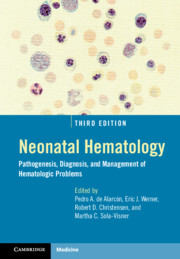Book contents
- Neonatal Hematology
- Neonatal Hematology
- Copyright page
- Contents
- Foreword
- Preface
- Contributors
- Section I Developmental Hematology
- Section II Bone Marrow Failure and Immune Disorders
- Section III Erythrocyte Disorders
- Section IV Platelet Disorders
- Section V Leucocyte Disorders
- Section VI Hemostatic Disorders
- Section VII Neonatal Transfusion Medicine
- Section VIII Neonatal Oncology
- Chapter 21 Neonatal Leukemia
- Chapter 22 Neonatal and Perinatal Solid Tumors
- Section IX Miscellaneous
- Index
- Plate Section (PDF Only)
- References
Chapter 22 - Neonatal and Perinatal Solid Tumors
from Section VIII - Neonatal Oncology
Published online by Cambridge University Press: 30 January 2021
- Neonatal Hematology
- Neonatal Hematology
- Copyright page
- Contents
- Foreword
- Preface
- Contributors
- Section I Developmental Hematology
- Section II Bone Marrow Failure and Immune Disorders
- Section III Erythrocyte Disorders
- Section IV Platelet Disorders
- Section V Leucocyte Disorders
- Section VI Hemostatic Disorders
- Section VII Neonatal Transfusion Medicine
- Section VIII Neonatal Oncology
- Chapter 21 Neonatal Leukemia
- Chapter 22 Neonatal and Perinatal Solid Tumors
- Section IX Miscellaneous
- Index
- Plate Section (PDF Only)
- References
Summary
Solid tumors in neonates can arise anywhere in the body and present unique challenges to clinicians. Benign tumors are most common [1], and are typically less amenable to chemotherapy or radiation and more in need of surgical approaches. Radiation’s role in childhood cancer is diminishing as better chemotherapeutic approaches are developed and its use in neonates is rare due to its devastating long-term toxicity. Finally, differences in neonatal physiology imparts a variable upon chemotherapy pharmacokinetics that is difficult to fully control and frequently results in greater toxicity. These factors, combined with the biology of the tumors uniquely seen in the neonate, worsen the survival for neonates with cancer. This chapter acquaints the clinician with the array of tumors most commonly found in the infant <28 days of age (Table 22.1).
- Type
- Chapter
- Information
- Neonatal HematologyPathogenesis, Diagnosis, and Management of Hematologic Problems, pp. 382 - 400Publisher: Cambridge University PressPrint publication year: 2021



